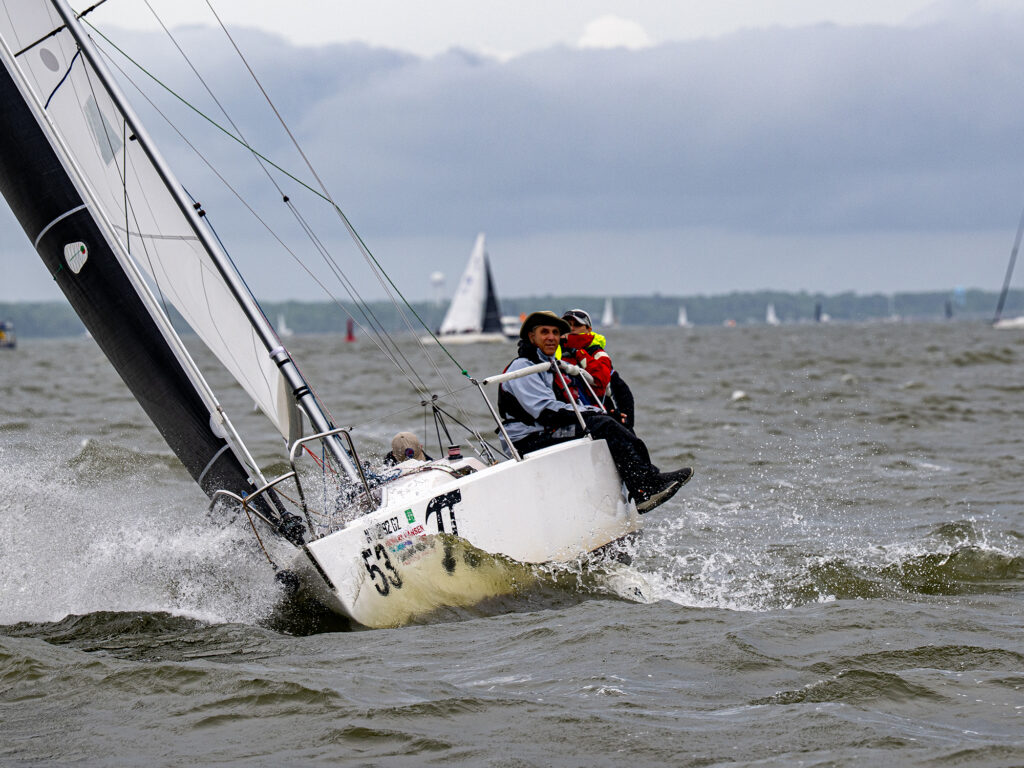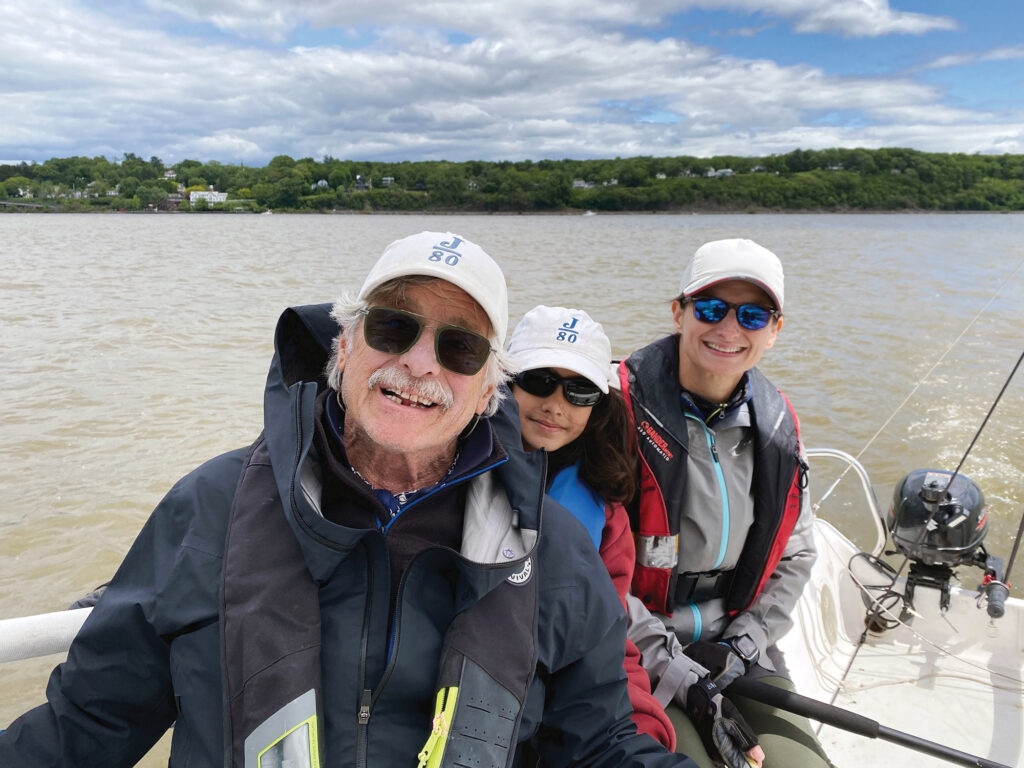PHRF for One-Design Perfection
 Sarah Olivieri’s team on the J/80 Pi, PHRF regulars at home in New Jersey, enjoy the one-design action at the Helly Hansen Sailing World Regatta Series in Annapolis, Maryland.
Walter Cooper
Sarah Olivieri’s team on the J/80 Pi, PHRF regulars at home in New Jersey, enjoy the one-design action at the Helly Hansen Sailing World Regatta Series in Annapolis, Maryland.
Walter Cooper
on a recent archaeological dig through a stack of external hard drives for an elusive photo, I stumble upon an untitled folder dated 10 years ago. Opening an image in the preview window, I know exactly where I’m at: NOOD Regatta; Annapolis, Maryland; 2015.
That and the rest of the photos look and feel like ages ago. Scrolling them, I expect to see boats that I haven’t seen in a long time, but with each tap of the down arrow key, I’m stuck in a time warp. One by one, they’re all the same boats I’d seen a week earlier at the Helly Hansen Sailing World Regatta in Annapolis.
There’s that same dark blue J/30 Avita and Bebop, and dozens of the same J/70s, Alberg 30s (minus the tie-dyes), J/22s…and the list goes on. These are the regulars, the local teams who race with us in Annapolis year after year, boats and faces aging in unison.
I’ve been working the SWRS-née-NOOD beat for 30 years, so whenever I arrive at the host club, I expect to see many of the same characters committed to their respective classes. The lifers. Considering how long I’ve been at it, I’m pretty good at recognizing and seeking out newcomers. Which is why I intentionally strike up a conversation with Sarah Olivieri and her father, Marshall Borris, wandering through J/80s on trailers at the Annapolis YC Sailing Center’s circle entrance, bustling with arrivals.
.embed-container { position: relative; padding-bottom: 56.25%; height: 0; overflow: hidden; max-width: 100%; } .embed-container iframe, .embed-container object, .embed-container embed { position: absolute; top: 0; left: 0; width: 100%; height: 100%; }My hunch is correct. They’ve just pulled in from New Jersey and have that look of: What do we do next? What’s the launch procedure? Where do we register? Where do we put the trailer?
I lob a softball Olivieri’s way: “Where are you coming in from?”
She and her 78-year-old father have made the short drive from New Jersey without incident. Their J/80 is the one with stained white gelcoat hull and a large numerical Greek pi decal near the bow (she later explains to me that pi has a value of 80). They’ve owned this particular J/80 for seven years and have been racing it exclusively in the Hudson River Yacht Racing Association’s PHRF fleet. This regatta will be their first time ever racing Pi in a one-design fleet.
Olivieri is “superexcited.” Racing against 22 boats in a new venue, with a lot of experienced teams, is a big deal.
I agree, leave them to it, wander off, and then later contemplate how exciting it will be for them to no longer be the loners of their hometown PHRF fleet; to check in with the class, play the game differently, and see where they stand on the ol’ level playing field, not to mention a playing field new to them. Trailering and traveling takes a higher commitment, and that’s what makes fast teams fast. Regatta voyaging takes us out of our comfort zone.
Olivieri started sailing with her father on a J/24 at 8 years old. The family J/35 came in high school, and the J lineage includes a cruising J/30, a J/22 and now the J/80. They are the quintessential J-boat family.
When the J/80 Worlds were contested in Newport, Rhode Island, in 2022, Olivieri convinced her father to charter their boat for the regatta and watch and learn from the sidelines. She used the opportunity to ask questions and check out how other teams rigged their boats. The experience was revealing, she says. “I learned that people in the class are so nice, like nobody’s keeping secrets. They’ll tell you all their tricks, especially if you’re interested,” she says. “It made me feel really welcomed and that I could do it.
“I was like, ‘You know, Dad? We could do that. We could do level racing.’”
She raced the Helly Hansen regatta in Annapolis this past year as a crew, and “this year I was like, I gotta bring my boat. I’m gonna do it—my first regatta, level racing with my own boat.”
Saying is one thing, but doing requires commitment. For Olivieri, who’d never towed a big keelboat beyond her own ZIP code, that meant a lot of trailer prep and a new tow vehicle. Then came the discovery of a bottom-paint issue this spring. “I started to work on it, and at a certain point, I had to call it,” Olivieri says. “I’m like, ‘It’s as good as it’s going to be.’ The big thing, the big win, is getting there, doing it, having a good time. And, you know, we’ll fix whatever we can later.”
Olivieri taking full responsibility for Pi is a generational passing of the family sailing torch. She grew up “very much like the sailor’s daughter,” she says. “I was pit early on because he wanted me to be safe, but the most interesting transformation was a couple of years ago, when we started sharing being captain.”
Health issues had forced her father to step back from sailing, and with Olivieri on the helm with a new team, they won every single race and their first season. “That was a big year for me,” she says. “I was excited and scared, and I really had to do well for him. I put a lot of pressure on myself.”
As newcomers to J/80 fleet sailing, there is a new kind of pressure in Annapolis, however, and the first day’s results are what she expected. They didn’t finish last, which is a good thing, but isn’t because of the Chesapeake’s swift and unpredictable currents winds—child’s play compared with Olivieri’s Hudson River training grounds.
 Back home on the Hudson with her father after the Annapolis regatta, Sarah Olivieri adds her son, Emiliano, to the three-generation J/80 squad.
Courtesy Sarah Olivieri
Back home on the Hudson with her father after the Annapolis regatta, Sarah Olivieri adds her son, Emiliano, to the three-generation J/80 squad.
Courtesy Sarah Olivieri
“Growing up, I used to think everywhere else must be harder, but for me, shifty is more like 180 degrees. There’s 3 knots of current and a lot of obstacles.”
All that trained her well for the Annapolis J/80 scrum. “What I’ve learned this weekend driving is that I’m not used to being close-quarters with other boats, except at the starts,” she tells me on the morning of the final day of racing. “I’m used to maneuvering really tight because of other obstacles. I felt very comfortable out there. I was very pleased. I’m like, ‘Give me 3 inches on each side, and I’m good.’”
With her father having to return home on the second day, Olivieri picked up a local connection, and they worked through the kinks.
“Everyone on the team is experienced,” she says, “but if we’re not experienced together, it’s gonna hurt a little—it’s all the little things. It’s the dance; it has to be in sync. I knew that coming down here.”
She also discovered that she’s surprisingly comfortable driving in the high-density fleet. She didn’t find it all the least bit intimidating. “People at home say, ‘Oh, it looks so scary to be with so many boats,’ but it’s not at all because everybody knows what they’re doing,” Olivieri says.
Her tactician for the weekend, David Doyle, is an experienced J/80 owner and racer, and he initially kept their starts on the conservative side. “He was nervous how I’d feel pushing up in the line, but he quickly learned that I’m very comfortable at very close quarters. So, eventually, we had some decent starts and some races.”
On the final day, a cold, windy and raining affair, Olivieri and her crew posted a sixth—a top-10 keeper and their best finish of the regatta. The whole experience was an epiphany of sorts for the one-design first-timer.
“I’ve realized here that I maybe know how to sail this boat faster than some of the class racers,” she tells me. “And that’s because at home we rarely have ideal J/80 conditions, and we race against boats that sail to their rating.”
She admits that she’s not as good—at the moment—with the tactics of being with other like boats, but adds, “I know how to sail it faster because of PHRF racing, where every second counts and you have to pay attention until you cross the line.”
Given her enthusiasm and commitment, I’m confident that I will see her again next year.
The post PHRF for One-Design Perfection appeared first on Sailing World.
- Home
- About Us
- Write For Us / Submit Content
- Advertising And Affiliates
- Feeds And Syndication
- Contact Us
- Login
- Privacy
All Rights Reserved. Copyright , Central Coast Communications, Inc.